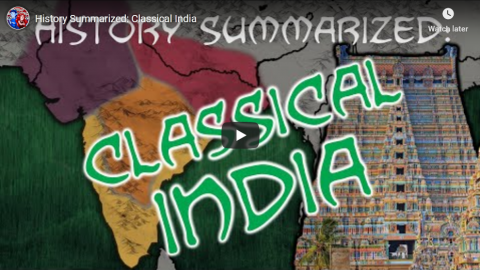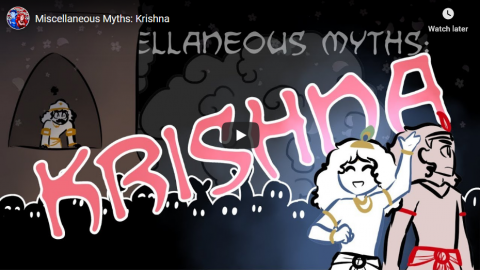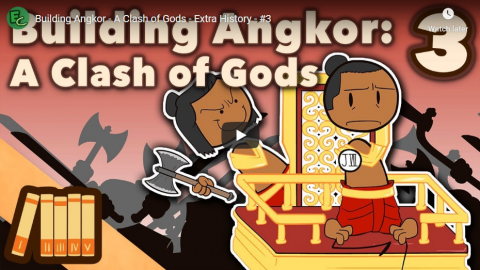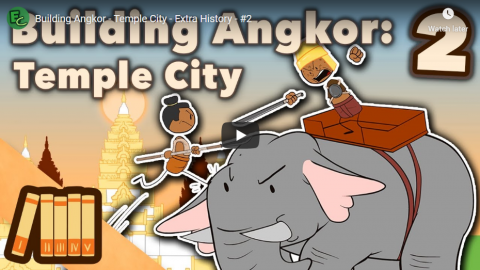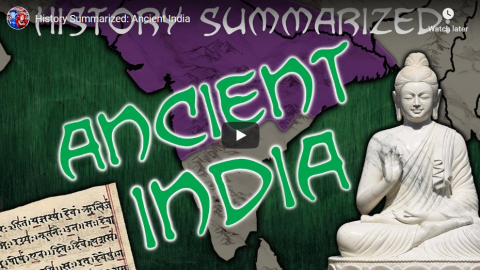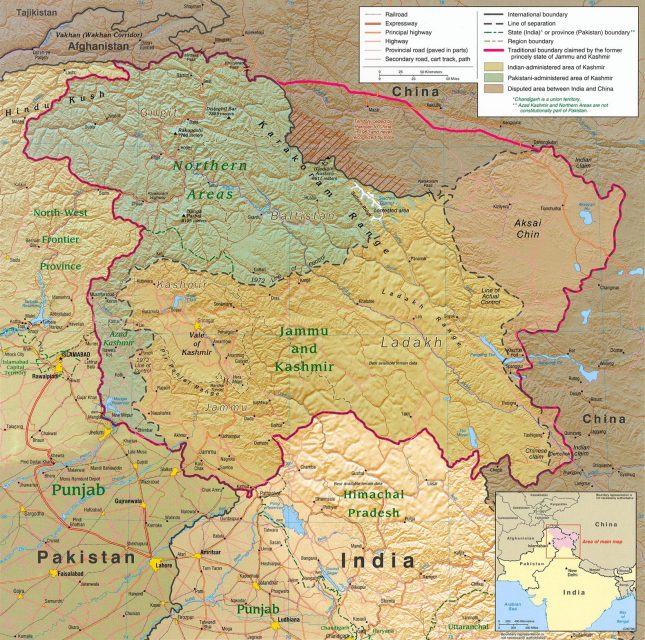Overly Sarcastic Productions
Published 17 Jan 2020Classical and Medieval Indian History is a tale of constant flux — but in between the dozens and hundreds of states at play across the peninsula, there are clear trends that arise. Let’s take this chapter of history as an opportunity to dig into different types of sources, and try and wrap our heads around a story that doesn’t fit neatly into a single chronology.
FURTHER SOURCES: The Discovery of India by Jawaharlal Nehru, “A History of India” by Michael H. Fisher (lecture courtesy of The Great Courses).
Our content is intended for teenage audiences and up.
PATREON: https://www.Patreon.com/OSP
DISCORD: https://discord.gg/y7uUnzJ
MERCH LINKS: https://www.redbubble.com/people/OSPY…
OUR WEBSITE: https://www.OverlySarcasticProductions.com
Find us on Twitter https://www.Twitter.com/OSPYouTube
Find us on Reddit https://www.Reddit.com/r/OSP/
January 18, 2020
History Summarized: Classical India
November 30, 2019
Miscellaneous Myths: Krishna
Overly Sarcastic Productions
Published 29 Nov 2019The man. The myth. The whole entire universe. It’s time to dive into Krishna’s youth and learn the backstory of everyone’s favorite blue dude!
Video requested by patron Antonio Juarez!
Join the official channel discord here! https://discord.gg/btEGDBf
PATREON: https://www.Patreon.com/OSP
MERCH LINKS: https://www.redbubble.com/people/OSPY…
OUR WEBSITE: https://www.OverlySarcasticProductions.com
Find us on Twitter https://www.Twitter.com/OSPYouTube
Find us on Reddit https://www.Reddit.com/r/OSP/
November 3, 2019
Building Angkor – A Drowning City – Extra History – #4
Extra Credits
Published 2 Nov 2019Join us on Patreon! http://bit.ly/EHPatreon
We’ve talked about the magnificence of Angkor at its peak, but how did this sprawling metropolis become a city of ruins? The city of Angkor depended on the reliability of the seasonal monsoon. Several decades of drought left them with little choice than to modify the whole water system. But when the waters returned, they returned in force. As did enemy forces. Thus begins the death spiral of the city of Angkor.
From the comments:
Extra Credits
1 day ago
Always 👏 maintain 👏 your 👏 water 👏 infrastructure !!!
October 29, 2019
Building Angkor – A Clash of Gods – Extra History – #3
Extra Credits
Published 26 Oct 2019Join us on Patreon! http://bit.ly/EHPatreon
Jayavarman VII, a Buddhist pacifist, was forced to give up his pacifism and rise to the throne at the age of 60. But once seated on the throne, he built Angkor Thom. The architecture was a fusion of buddhist and hindu stylings and included a comprehensive medical system. But will Angkor be able to stand after Jayavarman VII has passed?
Jayavarman VII the Great may be known as the greatest ruler of the Khmer, but he also wins the award for history’s best son. Making your mom the face for the goddess of wisdom is quite the Mother’s Day gift.
(Since folks have been asking for the metric conversions on our videos, 9 miles = 14.5 km at 4:52)
October 21, 2019
Building Angkor – Temple City – Extra History – #2
Extra Credits
Published 19 Oct 2019Join us on Patreon! http://bit.ly/EHPatreon
Let’s take a little tour around Suryavarman II crowning achievement, the temple that took only 33 years to complete, while Europeans were taking centuries to build their cathedrals. With a two mile long wall, gates large enough to allow elephants to pass and steps so steep that the average person needed to climb them like a ladder, Angkor Wat’s every feature was made to be impressive. But what lies at the heart might be surprising…
October 12, 2019
History Summarized: Ancient India
Overly Sarcastic Productions
Published 11 Oct 2019Go to http://www.audible.com/overlysarcastic or text
overlysarcasticto 500500 to get a free audiobook, 2 free Audible Originals, and 30-day free trial.In the first of what is sure to be a multi-part series, let’s take a look at the history of Ancient India, from the earliest civilization through the development of Sanskrit literature and all the way to the great Maurya Empire!
FURTHER READING: The Discovery of India, by Jawaharlal Nehru (https://en.wikipedia.org/wiki/The_Discovery_of_India)
PATREON: https://www.Patreon.com/OSP
DISCORD: https://discord.gg/sS5K4R3
MERCH LINKS: https://www.redbubble.com/people/OSPY…
OUR WEBSITE: https://www.OverlySarcasticProductions.com
Find us on Twitter https://www.Twitter.com/OSPYouTube
Find us on Reddit https://www.Reddit.com/r/OSP/
September 8, 2019
QotD: The Amritsar massacre and the partition of India
Although the movie [Gandhi] sneers at this reasoning as being the flimsiest of pretexts, I cannot imagine an impartial person studying the subject without concluding that concern for Indian religious minorities was one of the principal reasons Britain stayed in India as long as it did. When it finally withdrew, blood-maddened mobs surged through the streets from one end of India to the other, the majority group in each area, Hindu or Muslim, slaughtering the defenseless minority without mercy in one of the most hideous periods of carnage of modern history.
A comparison is in order. At the famous Amritsar massacre of 1919, shot in elaborate and loving detail in the present movie and treated by post-independence Indian historians as if it were Auschwitz, Gurkha troops under the command of a British officer, General Dyer, fired into an unarmed crowd of Indians defying a ban and demonstrating for Indian independence. The crowd contained women and children; 379 persons died; it was all quite horrible. Dyer was court-martialed and cashiered, but the incident lay heavily on British consciences for the next three decades, producing a severe inhibiting effect. Never again would the British empire commit another Amritsar, anywhere.
As soon as the oppressive British were gone, however, the Indians — gentle, tolerant people that they are — gave themselves over to an orgy of bloodletting. Trained troops did not pick off targets at a distance with Enfield rifles. Blood-crazed Hindus, or Muslims, ran through the streets with knives, beheading babies, stabbing women, old people. Interestingly, our movie shows none of this on camera (the oldest way of stacking the deck in Hollywood). All we see is the aged Gandhi, grieving, and of course fasting, at these terrible reports of riots. And, naturally, the film doesn’t whisper a clue as to the total number of dead, which might spoil the mood somehow. The fact is that we will never know how many Indians were murdered by other Indians during the country’s Independence Massacres, but almost all serious studies place the figure over a million, and some, such as Payne’s sources, go to 4 million. So, for those who like round numbers, the British killed some 400 seditious colonials at Amritsar and the name Amritsar lives in infamy, while Indians may have killed some 4 million of their own countrymen for no other reason than that they were of a different religious faith and people think their great leader would make an inspirational subject for a movie. Ahimsa, as can be seen, then, had an absolutely tremendous moral effect when used against Britain, but not only would it not have worked against Nazi Germany (the most obvious reproach, and of course quite true), but, the crowning irony, it had virtually no effect whatever when Gandhi tried to bring it into play against violent Indians.
Despite this at best patchy record, the film-makers have gone to great lengths to imply that this same principle of ahimsa — presented in the movie as the purest form of pacifism — is universally effective, yesterday, today, here, there, everywhere. We hear no talk from Gandhi of war sometimes being a “necessary evil,” but only him announcing — and more than once — “An eye for an eye makes the whole world blind.” In a scene very near the end of the movie, we hear Gandhi say, as if after deep reflection: “Tyrants and murderers can seem invincible at the time, but in the end they always fall. Think of it. Always.” During the last scene of the movie, following the assassination, Margaret Bourke-White is keening over the death of the Great Soul with an English admiral’s daughter named Madeleine Slade, in whose bowel movements Gandhi took the deepest interest (see their correspondence), and Miss Slade remarks incredulously that Gandhi felt that he had failed. They are then both incredulous for a moment, after which Miss Slade observes mournfully, “When we most needed it [presumably meaning during World War II], he offered the world a way out of madness. But the world didn’t see it.” Then we hear once again the assassin’s shots, Gandhi’s “Oh, God,” and last, in case we missed them the first time, Gandhi’s words (over the shimmering waters of the Ganges?): “Tyrants and murderers can seem invincible at the time, but in the end they always fall. Think of it. Always.” This is the end of the picture.
Richard Grenier, “The Gandhi Nobody Knows”, Commentary, 1983-03-01.
August 9, 2019
What’s happening in Jammu and Kashmir?
Pieter J. Friedrich reports on recent events concerning the unique constitutional status of Jammu and Kashmir within the Republic of India:
Terror grips the most militarized zone in the world after India’s Central Government terminated Jammu and Kashmir’s 70-year-old “special status” as the first step towards stripping the disputed region of statehood entirely.
Internationally infamous as the world’s hottest potential nuclear flashpoint, J&K originally acceded to India in 1947 only on the condition that the newly-formed country be restricted from interfering in the domestic affairs of the mountainous northern region. The agreement was sealed between the last king of J&K, Maharaja Hari Singh Dogra, and the representative of the British crown, Governor-General Lord Mountbatten. In 1949, when passage of the constitution formed the Republic of India, the Maharaja’s conditions for accession were enshrined in Article 370.
The crux of the article – in combination with Article 35A of 1954 – was that, while J&K accepted India’s handling of issues like defense and foreign policy, the state otherwise reserved the right to autonomy in handling its domestic affairs. Kashmiris, thus, lived under their own distinct laws. Notably, citizens of other parts of India were prohibited from settling permanently or owning property in Kashmir. In the eyes of many Kashmiris, this prevented settler colonialism. On August 5, 2019, the President of India abolished this “special status” by decree.
Simultaneously, Home Minister Amit Shah – charged with India’s internal security – introduced a bill in the upper house of parliament to strip J&K of statehood, downgrade it to a “Union Territory,” and partition the region.
As Shah did this, the Central Government shut down Kashmir. It imposed a virtual curfew, banning movement of the public, shuttering educational institutions, and barring all public assemblies or meetings. It severed communications, cutting off phone and internet access. And it conducted arrests of mainstream Kashmiri political leaders – such as former chief ministers Mehbooba Mufti and Omar Abdullah – on unknown charges.
India’s ruling Bharatiya Janata Party, which was just re-elected in May, campaigned on promises to scrap J&K’s “special status.” The BJP’s manifesto alleged that it was “an obstacle in the development of the state,” while Shah insisted it stood in the way of of Kashmir becoming an “integral party of India permanently” and was necessary for “national security.” Indeed, the tumultuous region has suffered a significant influx in violence in recent years.
Since 2014, when Prime Minister Modi’s regime first came to power, terrorist incidents in J&K have nearly tripled and security forces deaths have nearly doubled. According to a July 2019 UN report, independent bodies documented 159 security forces deaths in 2018 – a figure comparable to US troop fatalities in Iraq in 2009. The latest round of escalating tensions traces back to at least 2010, when mass protests erupted over an “encounter killing” of three civilians by Indian Army troops. Protests again erupted in 2016. During suppression efforts, security forces killed hundreds of protesters.
The Central Government has responded by flooding J&K with more and more soldiers. The small region – slightly smaller than the United Kingdom – is already occupied by a bare minimum of 500,000 troops. Since late July 2019, India has deployed nearly another 50,000.
Delhi has additionally responded by repeatedly dissolving J&K’s elected state government, imposing direct rule three times since 2015. The last time was in June 2018, after India’s ruling BJP withdrew from a coalition with then J&K Chief Minister Mufti – apparently because she advocated “reconciliation” instead of a “muscular security policy” as the most effective solution to the Kashmir conflict. Elections have not been allowed since 2014.
The ongoing occupation as well as the long-term use of direct rule – imposed for approximately ten of the past 42 years – contribute to the perception of Kashmiris that they are nothing more than vassals within the Republic of India.
March 31, 2019
QotD: Gandhi’s not-so-non-violent followers
… it is not widely realized (nor will this film tell you) how much violence was associated with Gandhi’s so-called “nonviolent” movement from the very beginning. India’s Nobel Prize-winning poet, Rabindranath Tagore, had sensed a strong current of nihilism in Gandhi almost from his first days, and as early as 1920 wrote of Gandhi’s “fierce joy of annihilation,” which Tagore feared would lead India into hideous orgies of devastation — which ultimately proved to be the case. Robert Payne has said that there was unquestionably an “unhealthy atmosphere” among many of Gandhi’s fanatic followers, and that Gandhi’s habit of going to the edge of violence and then suddenly retreating was fraught with danger. “In matters of conscience I am uncompromising,” proclaimed Gandhi proudly. “Nobody can make me yield.” The judgment of Tagore was categorical. Much as he might revere Gandhi as a holy man, he quite detested him as a politician and considered that his campaigns were almost always so close to violence that it was utterly disingenuous to call them nonviolent.
For every satyagraha true believer, moreover, sworn not to harm the adversary or even to lift a finger in his own defense, there were sometimes thousands of incensed freebooters and skirmishers bound by no such vow. Gandhi, to be fair, was aware of this, and nominally deplored it — but with nothing like the consistency shown in the movie. The film leads the audience to believe that Gandhi’s first “fast unto death,” for example, was in protest against an act of barbarous violence, the slaughter by an Indian crowd of a detachment of police constables. But in actual fact Gandhi reserved this “ultimate weapon” of his to interdict a 1931 British proposal to grant Untouchables a “separate electorate” in the Indian national legislature — in effect a kind of affirmative-action program for Untouchables. For reasons I have not been able to decrypt, Gandhi was dead set against the project, but I confess it is another scene I would like to have seen in the movie: Gandhi almost starving himself to death to block affirmative action for Untouchables.
From what I have been able to decipher, Gandhi’s main preoccupation in this particular struggle was not even the British. Benefiting from the immense publicity, he wanted to induce Hindus, overnight, ecstatically, and without any of these British legalisms, to “open their hearts” to Untouchables. For a whole week Hindu India was caught up in a joyous delirium. No more would the Untouchables be scavengers and sweepers! No more would they be banned from Hindu temples! No more would they pollute at 64 feet! It lasted just a week. Then the temple doors swung shut again, and all was as before. Meanwhile, on the passionate subject of swaraj, Gandhi was crying, “I would not flinch from sacrificing a million lives for India’s liberty!” The million Indian lives were indeed sacrificed, and in full. They fell, however, not to the bullets of British soldiers but to the knives and clubs of their fellow Indians in savage butcheries when the British finally withdrew.
Richard Grenier, “The Gandhi Nobody Knows”, Commentary, 1983-03-01.
November 27, 2018
QotD: Gandhi’s view of India as a nation
No one questions that the formative period for Gandhi as a political leader was his time in South Africa. Throughout history Indians, divided into 1,500 language and dialect groups (India today has 15 official languages), had little sense of themselves as a nation. Muslim Indians and Hindu Indians felt about as close as Christians and Moors during their 700 years of cohabitation in Spain. In addition to which, the Hindus were divided into thousands of castes and sub-castes, and there were also Parsees, Sikhs, Jains. But in South Africa officials had thrown them all in together, and in the mind of Gandhi (another one of those examples of nationalism being born in exile) grew the idea of India as a nation, and Muslim-Hindu friendship became one of the few positions on which he never really reversed himself. So Gandhi — ignoring Arabs and Turks — became an adamant supporter of the Khilafat [Caliphate] movement out of strident Indian nationalism. He had become a national figure in India for having unified 13,000 Indians of all faiths in South Africa, and now he was determined to reach new heights by unifying hundreds of millions of Indians of all faiths in India itself. But this nationalism did not please everyone, particularly Tolstoy, who in his last years carried on a curious correspondence with the new Indian leader. For Tolstoy, Gandhi’s Indian nationalism “spoils everything.”
Richard Grenier, “The Gandhi Nobody Knows”, Commentary, 1983-03-01.
November 7, 2018
QotD: Gandhi and the fall of the Caliphate
… it should not be thought for one second that Gandhi’s finally full-blown desire to detach India from the British empire gave him the slightest sympathy with other colonial peoples pursuing similar objectives. Throughout his entire life Gandhi displayed the most spectacular inability to understand or even really take in people unlike himself — a trait which V.S. Naipaul considers specifically Hindu, and I am inclined to agree. Just as Gandhi had been totally unconcerned with the situation of South Africa’s blacks (he hardly noticed they were there until they rebelled), so now he was totally unconcerned with other Asians or Africans. In fact, he was adamantly opposed to certain Arab movements within the Ottoman empire for reasons of internal Indian politics.
At the close of World War I, the Muslims of India were deeply absorbed in what they called the “Khilafat” movement — “Khilafat” being their corruption of “Caliphate,” the Caliph in question being the Ottoman Sultan. In addition to his temporal powers, the Sultan of the Ottoman empire held the spiritual position of Caliph, supreme leader of the world’s Muslims and successor to the Prophet Muhammad. At the defeat of the Central Powers (Germany, Austria, Turkey), the Sultan was a prisoner in his palace in Constantinople, shorn of his religious as well as his political authority, and the Muslims of India were incensed. It so happened that the former subject peoples of the Ottoman empire, principally Arabs, were perfectly happy to be rid of this Caliph, and even the Turks were glad to be rid of him, but this made no impression at all on the Muslims of India, for whom the issue was essentially a club with which to beat the British. Until this odd historical moment, Indian Muslims had felt little real allegiance to the Ottoman Sultan either, but now that he had fallen, the British had done it! The British had taken away their Khilafat! And one of the most ardent supporters of this Indian Muslim movement was the new Hindu leader, Gandhi.
Richard Grenier, “The Gandhi Nobody Knows”, Commentary, 1983-03-01.
October 9, 2018
Kingdom of Majapahit – Changing Winds – Extra History – #5
Extra Credits
Published on 6 Oct 2018When Islam arrived in Indonesia, life changed — except within Majapahit, where court drama kept them focused on themselves and unaware of the visits and alliances between Admiral Zheng He and the Sultanate of Malacca — forming new powers in the southern seas.
Support us on Patreon! http://bit.ly/EHPatreon
As we finished this episode, an even more devastating earthquake and tsunami struck the island of Sulawesi. Once again we’ve linked two fundraising efforts—one international aid organization, and another for a local effort. Any help would be deeply appreciated.
https://secure2.oxfamamerica.org/page…
https://kopernik.info/en/donate/palu-…
October 4, 2018
QotD: Gandhi in World War One
We are therefore presented with the seeming anomaly of a Gandhi who, in Britain when war broke out in August 1914, instantly contacted the War Office, swore that he would stand by England in its hour of need, and created the Indian Volunteer Corps, which he might have commanded if he hadn’t fallen ill with pleurisy. In 1915, back in India, he made a memorable speech in Madras in which he proclaimed, “I discovered that the British empire had certain ideals with which I have fallen in love …” In early 1918, as the war in Europe entered its final crisis, he wrote to the Viceroy of India, “I have an idea that if I become your recruiting agent-in-chief, I might rain men upon you,” and he proclaimed in a speech in Kheda that the British “love justice; they have shielded men against oppression.” Again, he wrote to the Viceroy, “I would make India offer all her able-bodied sons as a sacrifice to the empire at this critical moment …” To some of his pacifist friends, who were horrified, Gandhi replied by appealing to the Bhagavad Gita and to the endless wars recounted in the Hindu epics, the Ramayana and the Mahabharata, adding further to the pacifists’ horror by declaring that Indians “have always been warlike, and the finest hymn composed by Tulsidas in praise of Rama gives the first place to his ability to strike down the enemy.”
This was in contradiction to the interpretation of sacred Hindu scriptures Gandhi had offered on earlier occasions (and would offer later), which was that they did not recount military struggles but spiritual struggles; but, unusual for him, he strove to find some kind of synthesis. “I do not say, ‘Let us go and kill the Germans,’” Gandhi explained. “I say, ‘Let us go and die for the sake of India and the empire.’” And yet within two years, the time having come for swaraj (home rule), Gandhi’s inner voice spoke again, and, the leader having found his cause, Gandhi proclaimed resoundingly: “The British empire today represents Satanism, and they who love God can afford to have no love for Satan.”
The idea of swaraj, originated by others, crept into Gandhi’s mind gradually. With a fair amount of winding about, Gandhi, roughly, passed through three phases. First, he was entirely pro-British, and merely wanted for Indians the rights of Englishmen (as he understood them). Second, he was still pro-British, but with the belief that, having proved their loyalty to the empire, Indians would be granted some degree of swaraj. Third, as the home-rule movement gathered momentum, it was the swaraj, the whole swaraj, and nothing but the swaraj, and he turned relentlessly against the crown. The movie to the contrary, he caused the British no end of trouble in their struggles during World War II.
Richard Grenier, “The Gandhi Nobody Knows”, Commentary, 1983-03-01.
October 1, 2018
Kingdom of Majapahit – The Golden Reign – Extra History – #4
Extra Credits
Published on 29 Sep 2018The new sixteen-year-old king, Hayam Wuruk, had inherited an empire. Gajah Mada acted on his behalf, reshaping the way that the throne of Majapahit would be run, but he made a big mistake with the Sundanese princess…
Support us on Patreon! http://bit.ly/EHPatreon
September 27, 2018
QotD: Gandhi’s views on Britain
… as almost always with historical films, even those more honest than Gandhi, the historical personage on which the movie is based is not only more complex but more interesting than the character shown on the screen. During his entire South African period, and for some time after, until he was about fifty, Gandhi was nothing more or less than an imperial loyalist, claiming for Indians the rights of Englishmen but unshakably loyal to the crown. He supported the empire ardently in no fewer than three wars: the Boer War, the “Kaffir War,” and, with the most extreme zeal, World War I. If Gandhi’s mind were of the modern European sort, this would seem to suggest that his later attitude toward Britain was the product of unrequited love: he had wanted to be an Englishman; Britain had rejected him and his people; very well then, they would have their own country. But this would imply a point of “agonizing reappraisal,” a moment when Gandhi’s most fundamental political beliefs were reexamined and, after the most bitter soul-searching, repudiated. But I have studied the literature and cannot find this moment of bitter soul-searching. Instead, listening to his “inner voice” (which in the case of divines of all countries often speaks in the tones of holy opportunism), Gandhi simply, tranquilly, without announcing any sharp break, set off in a new direction.
It should be understood that it is unlikely Gandhi ever truly conceived of “becoming” an Englishman, first, because he was a Hindu to the marrow of his bones, and also, perhaps, because his democratic instincts were really quite weak. He was a man of the most extreme, autocratic temperament, tyrannical, unyielding even regarding things he knew nothing about, totally intolerant of all opinions but his own. He was, furthermore, in the highest degree reactionary, permitting in India no change in the relationship between the feudal lord and his peasants or servants, the rich and the poor. In his The Life and Death of Mahatma Gandhi, the best and least hagiographic of the full-length studies, Robert Payne, although admiring Gandhi greatly, explains Gandhi’s “new direction” on his return to India from South Africa as follows:
He spoke in generalities, but he was searching for a single cause, a single hard-edged task to which he would devote the remaining years of his life. He wanted to repeat his triumph in South Africa on Indian soil. He dreamed of assembling a small army of dedicated men around him, issuing stern commands and leading them to some almost unobtainable goal.
Gandhi, in short, was a leader looking for a cause. He found it, of course, in home rule for India and, ultimately, in independence.
Richard Grenier, “The Gandhi Nobody Knows”, Commentary, 1983-03-01.

